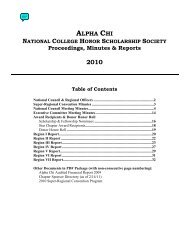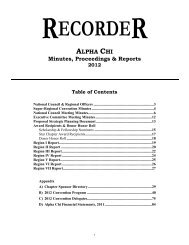Vol. 52, No. 1, 2009 - Alpha Chi
Vol. 52, No. 1, 2009 - Alpha Chi
Vol. 52, No. 1, 2009 - Alpha Chi
You also want an ePaper? Increase the reach of your titles
YUMPU automatically turns print PDFs into web optimized ePapers that Google loves.
6 Th e Cr u s a d e s a s Pr o pa g a n d a<br />
unable to take advantage of the dissension” (117). Outright hostilities between Muslims<br />
could be quite common. The experience of Zangi is a pertinent example. When Zangi, an<br />
Arab figure of authority, marched on Baghdad to confront the caliph there, his troops were<br />
slaughtered and he escaped only with the aid of a Kurdish officer, Ayyub. He later rewarded<br />
this officer, who happened to be the father of Saladin (Maalouf 117). Additionally, the city<br />
of Damascus actually requested protection from the French against attack by their Muslim<br />
neighbors (Maalouf 127). Those who wish to condemn the West for the part it played in the<br />
Crusades must also recognize the part that Muslims played in the destabilization of the Holy<br />
Land as well as the violence that ensued. Solely attributing the violence of the Crusades to<br />
the Europeans fails to consider the violence and destruction wrought by Arabs as well.<br />
If the Crusades are examined through the lens of these conflicts and their history, a very<br />
different interpretation emerges. Clearly, a tradition of violence and bloodshed between<br />
Muslims and Christians had existed long before the Crusades began. The First Crusade<br />
and each subsequent Crusade did not arise in a vacuum, nor did they fail to influence each<br />
other. Although the historical association of Christianity and Islam is very important, several<br />
events did help to stimulate a response from many echelons of society that may not have<br />
engaged in an outright war before.<br />
Pilgrims had been traveling to the Holy Land since the beginning of Christianity, but in<br />
the early 11th century, restrictions were placed on Christian pilgrims by the Fatimid imam<br />
al-Hakim. Sentiments were further exacerbated when the Church of the Holy Sepulcher<br />
was destroyed in 1009. These events inflamed the West, especially the papacy, and may<br />
very well be attributed as<br />
“contributory causes of<br />
the Crusades” (Zacour and<br />
Hazard 42). The many conflicts<br />
between Islam and<br />
Christian territories may<br />
have already produced an<br />
environment susceptible<br />
to crusader rhetoric, which<br />
was only compounded by<br />
pleas from the Byzantine<br />
Empire for aid against the<br />
invading Muslims. If all of<br />
Clearly, a tradition of violence<br />
and bloodshed between<br />
Muslims and Christians<br />
had existed long before<br />
the Crusades began.<br />
these events are considered, the conflict in the Holy Land was not an aggressive invasion<br />
without prior contributory events but was rather a continuation of a conflict that had existed<br />
for centuries. Thus, the Crusades were not examples of wanton aggressive Western imperialism,<br />
as they have been depicted for centuries, but were rather another conflict in a series<br />
of violent relations.<br />
III. Historical Irrelevance of the Crusades in the Holy Land<br />
While the Crusades and the many conflicts with Arabic armies have been incorporated<br />
into Western history as an integral part of that history, such was not the case in the histories<br />
of the Middle East. In the 20th and 21st centuries, many organizations and governments<br />
have harkened back to the Crusades as a propaganda tool to inflame anti-Americanism and









